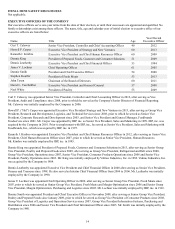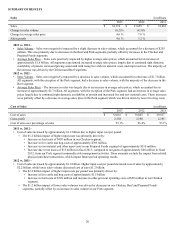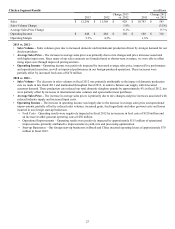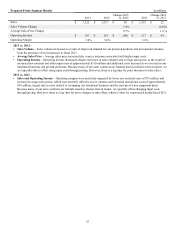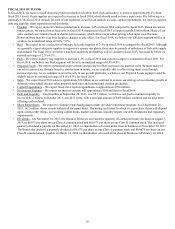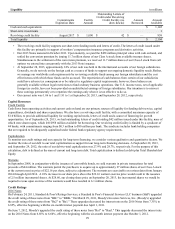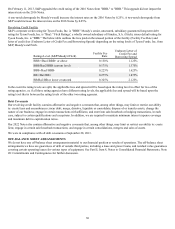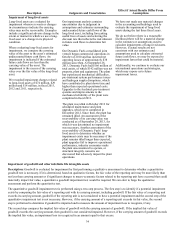Tyson Foods 2013 Annual Report Download - page 24
Download and view the complete annual report
Please find page 24 of the 2013 Tyson Foods annual report below. You can navigate through the pages in the report by either clicking on the pages listed below, or by using the keyword search tool below to find specific information within the annual report.
24
Beef Segment Results in millions
2013 2012 Change 2013
vs. 2012 2011 Change 2012
vs. 2011
Sales $ 14,400 $ 13,755 $ 645 $ 13,549 $ 206
Sales Volume Change (1.8)% (11.3)%
Average Sales Price Change 6.6 % 14.4 %
Operating Income $ 296 $ 218 $ 78 $ 468 $ (250)
Operating Margin 2.1% 1.6% 3.5%
2013 vs. 2012 –
• Sales Volume – Sales volume decreased due to less outside trim and tallow purchases, partially offset by increased production
volumes.
• Average Sales Price – Average sales price increased due to lower domestic availability of fed cattle supplies, which drove up
livestock costs.
• Operating Income – Operating income increased due to improved operational execution, less volatile live cattle markets and
improved export markets, partially offset by increased operating costs.
2012 vs. 2011 –
• Sales and Operating Income –
• Average sales price increased due to price increases associated with increased livestock costs. Sales volume decreased due
to a reduction in live cattle processed and outside tallow purchases. Operating income decreased due to higher fed cattle
costs and periods of reduced demand for beef products, which made it difficult to pass along increased input costs, as well
as lower sales volumes and increased employee related operating costs.
Pork Segment Results in millions
2013 2012 Change 2013
vs. 2012 2011 Change 2012
vs. 2011
Sales $ 5,408 $ 5,510 $ (102) $ 5,460 $ 50
Sales Volume Change (3.6)% 2.4 %
Average Sales Price Change 1.9 % (1.5)%
Operating Income $ 332 $ 417 $ (85) $ 560 $ (143)
Operating Margin 6.1% 7.6% 10.3%
2013 vs. 2012 –
• Sales Volume – Sales volume decreased as a result of balancing our supply with customer demand and reduced exports.
• Average Sales Price – Demand for pork products improved, which drove up average sales price and livestock cost despite a
slight increase in live hog supplies.
• Operating Income – While reduced compared to prior year, operating income remained strong in fiscal 2013 despite brief
periods of imbalance in industry supply and customer demand. We were able to maintain strong operating margins by
maximizing our revenues relative to the live hog markets, partially due to operational and mix performance.
• Derivative Activities – Operating results included net losses of $15 million in fiscal 2013, compared to net gains of $66
million in fiscal 2012 for commodity risk management activities related to futures contracts. These amounts exclude the
impact from related physical sale and purchase transactions, which impact current and future period operating results.
2012 vs. 2011 –
• Sales and Operating Income –
• Average sales price decreased due to increased domestic availability of pork products, which drove lower live hog costs.
Operating income decreased due to compressed pork margins caused by the excess domestic availability of pork products.
We were able to maintain strong operating margins by maximizing our revenues relative to the live hog markets, partially
due to strong export sales and operational and mix performance.
• Derivative Activities – Operating results included net gains of $66 million in fiscal 2012, compared to net losses of $32
million in fiscal 2011 from commodity risk management activities related to futures contracts. These amounts exclude the
impact from related physical sale and purchase transactions, which impact current and future period operating results.


